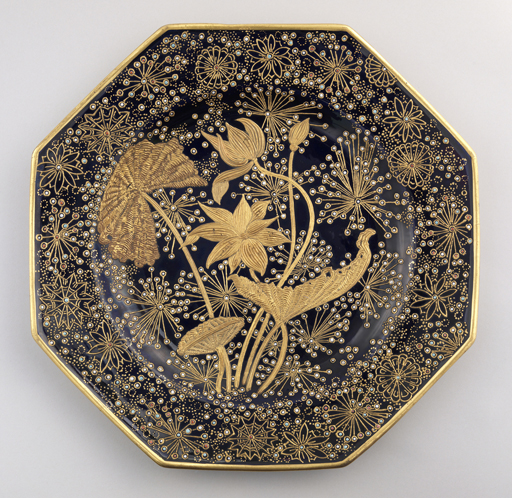In the last quarter of the nineteenth century the Greenpoint neighborhood of Brooklyn was a hub for ceramic production and home to at least a dozen major firms. The beaches of the East River offered plentiful white sand and underdeveloped land near the shore accommodated the building of large factories. These firms produced a broad range of wares. Some manufactured jugs, jars, crocks and flowerpots; others made fancy table wares as well as household articles such as doorknobs, drawer pulls, and buttons for clothing. The Faience Manufacturing Company was founded in Greenpoint in 1881 and the quality of its output peaked in 1884 when the company hired English-born and trained Edward Lycett as artistic director. His interest in exotic and historical shapes and designs revitalized the business and distinguished the Faience Manufacturing Company in its production of “art pottery.” Francis Lycett, son of Edward and the designer of this plate, joined the firm in about 1885 and worked under the influence of his father and in conjunction with decorators on staff including Sidney Thomas Callowhill, responsible for this plate. This piece’s octagonal form with a band along the rim and the attenuated floral decorations recall Japanese ceramics and epitomize the taste of the Aesthetic movement. The plate exhibits two signatures of the Faience Manufacturing Company’s production: raised gold paste decoration and a rich dark blue background.
In 1895, noted ceramic historian Edwin AtLee Barber published an article on Edward Lycett entitled “The Pioneer of China Painting in America.” While praising Edward’s work, the article also mentioned that “three sons inherit the artistic temperament of the father and have been accustomed from boyhood to assist their father in his classes. In this manner they have all become remarkably efficient as teachers and have become widely known as professional decorators.”[1] In 1896 in the wake of this positive review, the Smithsonian acquired a number of pottery pieces made by Edward Lycett and his son William, including tiles, cups and saucers, vases, and a card receiver. The Smithsonian later mounted an exhibition of the Lycett family’s work in 1939, the year that this plate was added to the collection, therefore suggesting that it too was a part of the exhibition.
Emily Orr is Assistant Curator of Modern and Contemporary American Design at Cooper Hewitt, Smithsonian Design Museum.
[1] Edwin AtLee Barber, “The Pioneer of China Painting in America.” New England Magazine 13 (September 1895), p 45.

3 thoughts on “Nineteenth-Century Glitz in Greenpoint”
Jeannine Falino on March 22, 2015 at 10:54 am
Hi Emily:
We included the Lycett plate in “Gilded New York: Design, Fashion Society” at the Museum of the City of New York [which is now running in its second year with some changes], and I was so taken with it’s beauty. Also wanted to congratulate you on your new post – I am sure you will bring great distinction to this very fine collection.
Emily Orr on March 24, 2015 at 3:00 pm
Hi Jeannine,
Thank you very much for your kind note! I will look forward to visiting MCNY to see the latest iteration of Gilded New York!
Kathleen Wentworth on July 31, 2019 at 6:10 pm
I am doing research on the connection between Sidney T. Callowhill and Tiffany Co. I would appreciate any leads you may have! Thank you